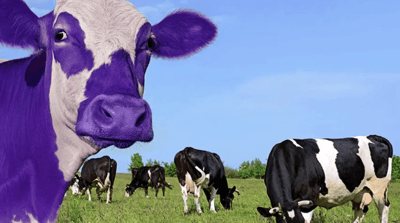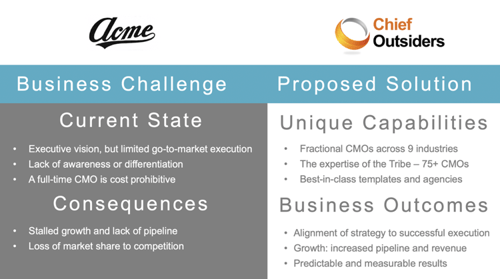CEO Blog - Advice for CEOs on growth and scaling
The SaaS Marketing Playbook Part 1 | Positioning: Finding Your Purple Cow in the Herd

Most marketers may not think they have anything in common with cattle ranchers, but it requires a trip to the Old West to fully understand the history of branding – a term which has significance for both.
The National Cowboy Museum explains that branding, in the old days, “provided a way for ranchers to stake their claim on cattle and other livestock, while deterring theft from rustlers.”
Though few bovines stampede through the average company, we can get a sense for why branding, today, bears more than a passing resemblance to its early cattle-theft-deterrent origins.
In short, it is thus: Branding, for companies, is the way that we stake our claim on our corner of the marketplace. If done correctly, our brand not only protects and reflects what makes us distinct, but it can add the “sizzle” to the proverbial “steak.”
 Think of it, as Seth Godin writes in his book, “Purple Cow: Transform Your Business by Being Remarkable, as the eponymous cow pictured here. You, your company, and your brand, are hoping to stand out from the crowd. By projecting these differences, you can own the conversation, and by owning the conversation, you own your market.
Think of it, as Seth Godin writes in his book, “Purple Cow: Transform Your Business by Being Remarkable, as the eponymous cow pictured here. You, your company, and your brand, are hoping to stand out from the crowd. By projecting these differences, you can own the conversation, and by owning the conversation, you own your market.
In this blog series, I’d like to help you think about how to be the purple cow – to think differently about marketing, and about the brand that makes you special. As you walk toward greener marketing pastures, we will break down the programs that make marketing work. We'll cover branding, positioning, and market segmentation, campaigns and content, and the metrics that matter.
Positioning: A Multi-Billion-Dollar Proposition
But, first, and foremost, we need to kick up our brand so that it sears itself into the consciousness of our buying public. No less than our meal ticket is at stake: The B2B SaaS market is on track to be a $600 billion business by 2023, but brand loyalty is all over the place. Only 11 percent of companies have inked a deal of three years or longer, while 48 percent of companies are satisfied to sign annually.
Solving the scourge of churn will take more than just beating the competition on price – we need to truly understand our value, via our brand and market positioning.
Let’s start with brand – leaving the cows behind, a good SaaS brand requires a recipe that includes vision, mission, values, and your value proposition. Let’s take a look at the ingredients individual, and their significance to the whole.
- Vision: Your future state over a period of time, and where you hope to arrive. Your vision should be aspirational -- something that gets you and your employees out of bed in the morning and excited to go to work.
- Mission: The steps you take, day in and day out, to realize your vision. As you achieve milestones toward your vision, make sure to share them with your employees and customers!
- Values: “Who you are” as an organization - what people do you hire, and how do you work together. Make sure to reinforce your values in your communications, especially to acknowledge stellar performance or to deal with tough times.
- Value Proposition: What makes you different? What are you taking to market that can uniquely solve a problem in a way that nobody else can?
With this recipe in place, you can now look at what drives behavior in your market, and how your branding recipe matches up with these market conditions. For example, when a new cloud technology is released, how does the market respond? How does it affect the regulatory environment? What are the security concerns? For example, if you serve the healthcare vertical, the creation of HIPAA was a formative event. Without the ability to comply with this event, companies would not have been able to go far. Position yourself to take advantage of that event, better than anybody else can.
Next, consider your markets – particularly, the personas of your likely consumer; the pain that would drive their adoption of your product; and the connection between different personas. Let me explain further: When personas “talk” to each other, they reference each other and share best practices -- and the vendors they love -- in something we call the advocacy effect.
This advocacy effect is powerful - your customers, at no cost to you, are selling your solution to their peers (a.k.a. Your prospects). This effect can even be more effective than your own salespeople. Why? Well, consider this: They already have a relationship with the prospect, and they have personal experience with the problem. Getting to know this a collection of personas with similar pain points or problem who talk to each other is the key to unlocking your market segment.
Persona-Driving Success
Let me share an anecdote about a SaaS company that successfully completed this evolution. The company had not defined its positioning, and instead, was simply cranking out deals and offers, but not truly getting to the heart of how they solved the prospect’s pain.
Working with their executive team, we created a new positioning statement that addressed the essence of how their product uniquely solved their buyers’ pain. By six months after this redefinition, the company’s pipeline increased by 95 percent while the sales cycle was cut by 80 percent, from four months to 30 days.
So, where does positioning come in in all this? Well, let me share a little positioning secret sauce. Remember that putting together your value proposition is important, because it speaks to your uniqueness – like that purple cow, above. Owning the conversation with your market requires keen branding and positioning – basically, putting all of this together to come up with your own cow, in whatever shade suits you (except black, of course), in a way that is simple, powerful, and memorable.
Positioning “Secret Sauce”
The core of this concept is outlined in the below illustration -- a gap analysis exercise adapted from Force Management methodology. When conducting this analysis with your prospects, you start by addressing their business challenge, and how your solution can solve that challenge. As you can see, there are four components within the business challenge, and the proposed solution.
Let’s cover these four components in more detail.
First, understand their current state. Here is where you should get a lot of acceptance and “head-nodding.” Next, talk about the consequences of staying in that current state. Here is where you identify the negative effects to your prospect of staying in that current state. By understanding these consequences, the prospect should have a growing sense of urgency to move forward.
Now talk about how your solution can take them to a more ideal future state. This can be something like a better approach or process, and how your solution has unique capabilities to support that approach. Illustrate how your solution overcomes those negative consequences. Then describe the better business outcomes associated with that future state – you can use a tool like an ROI calculator here.
Finally, reinforce the value of your solutions with proof points that support the better business outcomes. This is a good time to use quotes from existing customers explaining why they switched to your solution and the value they realized.
Hopefully, you now understand how a little bit of bovine insights can make a big difference in your market. Stay tuned. We’ll continue to develop our SaaS marketing playbook in our next blog by looking at demand generation – some strategies you can employ to hook consumers on your story and purchase your product.
Topics: Marketing Plan for SaaS, SaaS Strategy
Mon, Feb 22, 2021Related Articles

- Press Releases
- Careers
- Case Studies
- Marketing Consultant Company
- Marketing Strategy Consultants
- Marketing Plan Consultants
- B2B Marketing Consultants
- Virtual CMO
- Marketing Consultant Outsourcing
- Fractional CMO
- What is a Fractional CMO
- Healthcare Marketing Consultant
- Marketing Consultant Houston TX Texas
- Marketing Consultant Texas TX
- Marketing Consultant Bay Area
- CEO Blog
- Ebooks Plus
- Executive Marketing Consultants
- Product Marketing Consultants
- B2C Marketing Consultants
- Virtual Marketing Consultants
- Senior Marketing Consultants
- Temporary CMO
- Hire a CMO
- Fractional CMO Salary
- Fractional CMO Responsibilities
- Marketing Consultant Austin TX Texas
- Marketing Consultant Dallas TX Texas
- Marketing Consultant San Antonio
- Helping Private Equity
- Private Equity Blog
- Leadership Team
- Privacy Policy
- Business Marketing Consultants
- Strategic Marketing Consultants
- Marketing Technology Consultants
- Sales and Marketing Consultants
- CMO Job Description
- CMO Salary
- Fractional CMO Agency
- Fractional CMO Services
- CPG Marketing Consultant
- Marketing Consultant San Diego
- Partners
Houston, TX 77056
© 2023 Chief Outsiders


